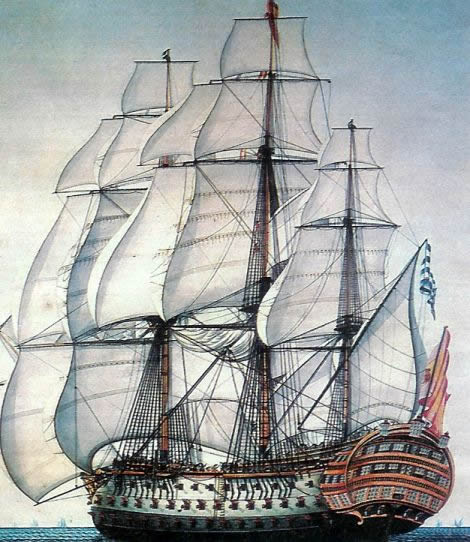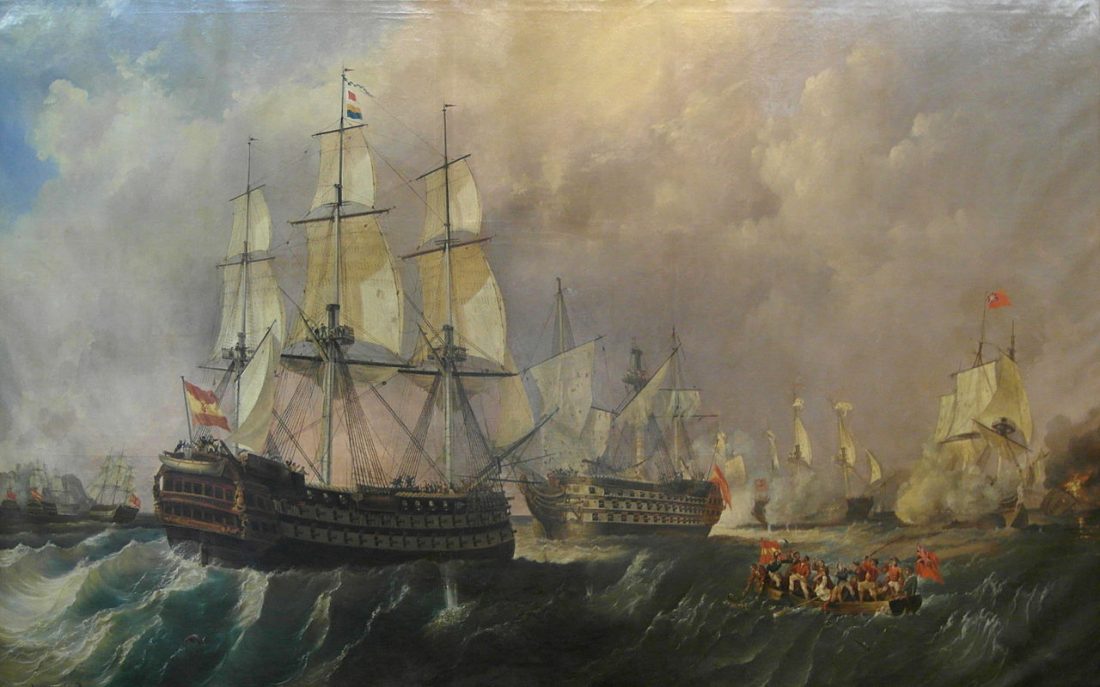Captain Richard Bowen, Beau Ideal of a Naval Officer
Part 3 of 3

Captain Richard Bowen with wound patch on his cheek
This article brings to a tragic conclusion the story of the splendid Captain Richard Bowen (1761-1797) which was told in my blogs of 11.05.18 (Click here to read if you missed it then) and 01.06.18 (Click here to read it). He was the epitome of the dashing frigate captain and in his short life his exploits as such were, if anything, more impressive than those of any fictional hero.
The end of the last article left Bowen at the end of 1796, still in command of his 32-gun frigate HMS Terpsichore, in which he had already proved so successful. In the year that followed – that which would see his death – he was to be responsible for the most notable of all his exploits when, with consummate daring, he engaged the largest warship in the world, alone, with his grossly out-gunned frigate.
Built in 1768, at Havana, in Cuba, and initially armed with 112 guns, Spain’s Santísima Trinidad was a monster at launch. She had grown even more powerful by 1796 when her spar deck had been enclosed between quarterdeck and forecastle, and her armament increased to 130 guns. This behemoth should be compared with the standard “74” which was to be the workhorse of the British and French Navies in this era and the Santísima Trinidad’s size, and her demand for massive crew numbers, led her to being somewhat of an unwieldy liability that was nicknamed “El Ponderoso”.

Santísima Trinidad – Wikipedia
Spain was to be an ally of France in the much of Revolutionary War (and for part of the Napoleonic Wars thereafter). In 1797, on 14th February, the Santísima Trinidad was the flagship of the Spanish commander of a fleet of twenty-four ships of the line and seven frigates that met a British fleet under Sir John Jervis off Cape St. Vincent in Southern Portugal. Though heavily outnumbered – he had fifteen ships-of-the-line and five frigates – Jervis won a stunning victory, made possible by superior tactics, splendid gunnery and the bloody-minded aggression of a subordinate commander, Horatio Nelson. The Santísima Trinidad’s size acted like a magnet, initially subjected to attack by Nelson himself in HMS Captain, and thereafter by six other ships. Heavily damaged, dismasted, with half of her crew killed or wounded, she struck her colours. In the heat and confusion of battle however no British prize crew was sent aboard and she was saved by the intervention of two other Spanish ships, a ‘74’ named the Infante don Pelayo (74) and another ponderous giant, the 112-gun Príncipe de Asturias.

Infante don Pelayo going to rescue Santisima Trinidad at Battle of Cape St Vincent
Captain Richard Bowen was at Gibraltar with Terpsichore when news arrived of Jervis’s victory and he set out with other frigates to join the fleet and to locate surviving Spanish ships. The weather was bad but the crippled Santísima Trinidad was spotted limping towards the shelter of Cadiz. She was flying the British Union Flag above her own colours, indicating that she was in the hands of a British prize-crew, but sea conditions made it impossible to close safely to confirm. It was however suspected that these colours were being used as a blind. As the frigates lost contact with the Spanish warship in the poor conditions, Bowen pressed on to report the sighting to Jervis. As Terpsichore returned to join the other frigates the Santísima Trinidad was again located. Bowen decided to take her and, undeterred by his opponent’s size, opened fire, killing nine men and wounding many more. The Spaniards responded and, judging discretion to be the better part of valour, Bowen broke off the engagement. The Santísima Trinidad finally reached Cadiz in safety. Repaired, and with her armament now increased to 136 guns, she was to participate in the Battle of Trafalgar in October 1805. Once more pounded by several ships simultaneously and once more dismasted, she was to strike her colours yet again. She was scuttled by her British captors in the days following the battle – probably without much regret, given that she had proved herself again to be unwieldy and essentially useless.
Bowen remained characteristically daring in the coming months, frustrating an attempt by Spanish ships to slip out of Algeciras with troops and driving them back. His area of operations was now shifted out into the Atlantic to the Canary Islands and on the night of 17/18th April 1797, Bowen sent six boats from the Terpsichore and the frigate HMS Dido into the bay of Santa Cruz de Tenerife to “cut out” the Príncipe Fernando, one of two Spanish vessels anchored there, with only a skeleton crew on board. Approaching under cover of darkness, the boarding parties swarmed on to the Principe and took her successfully out to sea under sail and towed by the British boats despite gunfire from shore and from the second Spanish frigate.

“Horatio Nelson when wounded at Teneriffe” Richard Westall RA (1765 – 1836)
British efforts, under the direction of Nelson, were now focussed on capture of Tenerife. The Terpsichore participated in a bombardment of Spanish shore defences on 5th July, a violation of Nelson’s own sound dictum that “A ship’s a fool to fight a fort”. Two weeks later, on 24th July, an attempt was made to storm the harbour’s mole in boats – reminiscent of Zeebrugge in 1918 – and to disable the guns mounted there. As always, leading from the front, and with a force of some fifty men behind him, Bowen carried the guns and was advancing into the town itself when met with a hail of grapeshot. Bowen was killed outright and Nelson, who was following behind with another group was also hit. With his right arm shattered, Nelson was carried to a boat and taken off. The assault, now abandoned, had been a massive failure – the only one in Nelson’s career, and a disaster too for himself personally, for his arm had to be amputated in the coming hours. Bowen’s body was recovered under truce the next morning and thereafter buried at sea.
Thus ended at the age of thirty-six the life of one of the most talented and intrepid commanders of the era. Nelson was to say of him that “…a more enterprising, able, and gallant officer, does not grace His Majesty’s naval service” – an epitaph that any man might envy.
The wars had yet almost two decades to run. Had he survived, Bowen might have attained very high rank and would be more widely remembered today. He deserves it.
Do you read on Kindle?
Do you enjoy naval fiction?
If you’re a Kindle Unlimited subscriber you can read any of the six Dawlish Chronicles novels without further charge. They are also available for purchase on Kindle or as stylish 9X6 paperbacks.
Click on the banner below for more details
Registering for the Dawlish Chronicles mailing list by clicking on the banner below, will keep you updated on new books and facilitates e-mail contact between Antoine Vanner and his readers for discussion of issues arising.
Suggestions and comment are always welcome and all emails are replied to. Free short stories, available only to those on the list, are also made available at intervals.


